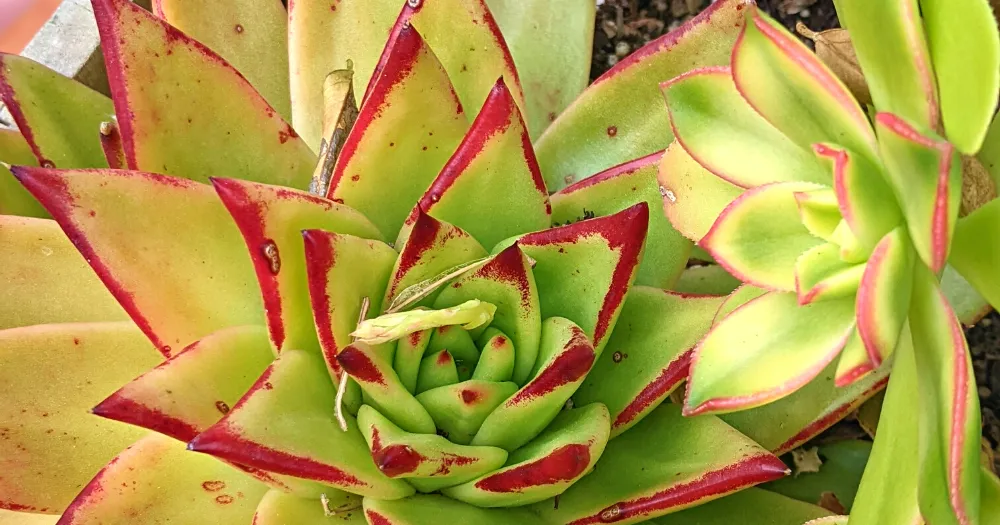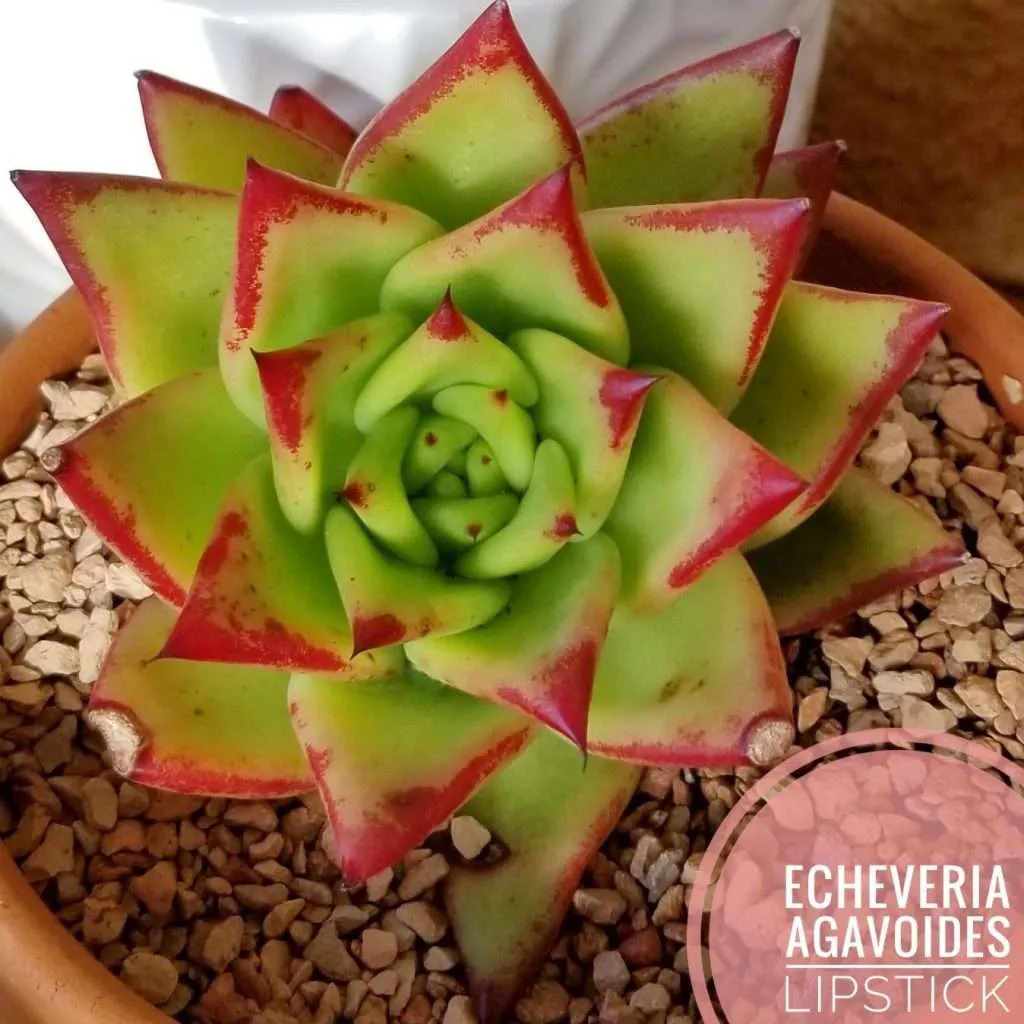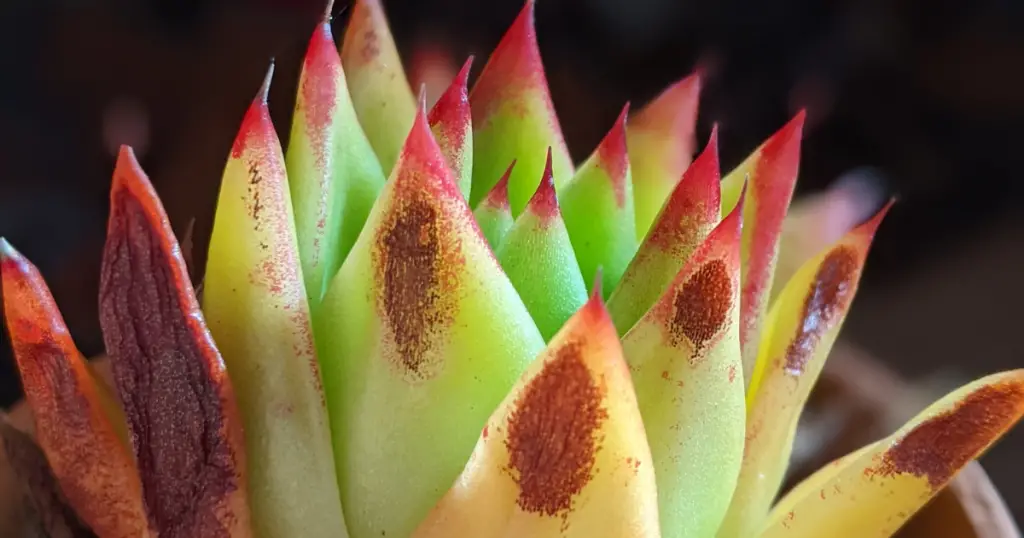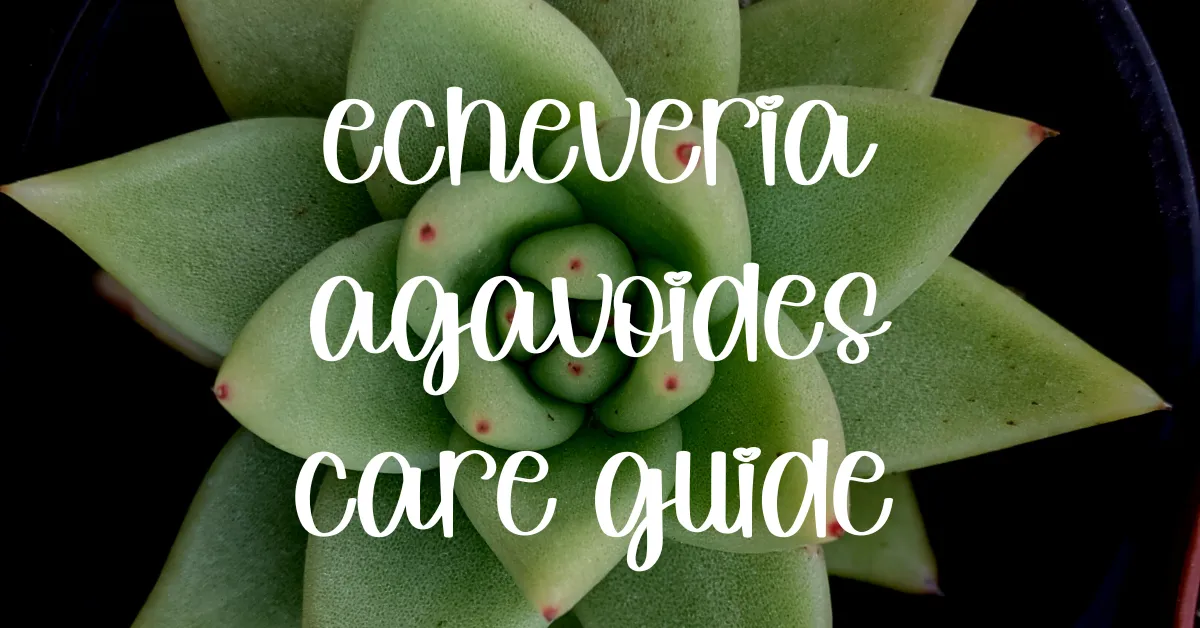Echeveria agavoides ‘Lipstick’ is a striking succulent featuring vibrant crimson margins on otherwise green triangular leaves. This natural mutant form of Echeveria agavoides grows into dense rosettes, reaching six to twelve inches in diameter at maturity. The lush green foliage is framed by a bright crimson edge, creating a dramatic two-tone effect that attracts attention.
In addition to the stunning leaves, Echeveria agavoides ‘Lipstick’ produces short stalks topped with bright yellow flowers accented by a red tip. The cheerful blooms emerge in spring and summer, adding pops of warm color that complement the plant’s bold hue. Though compact, Echeveria agavoides ‘Lipstick’ has a bold presence perfect for tabletops or landscape. With its robust shape, vivid pigments and striking color combinations, it helps bring vibrant energy to any space. Echeveria agavoides ‘Lipstick’ is an easy to care for plant that rewards with beauty and drama.
Dig in!

How do you water Echeveria agavoides ‘Lipstick’?
Water is essential for your Echeveria agavoides ‘Lipstick’ to thrive (obv!), but too much of a good thing can lead to root rot. Pay close attention to the soil and plant’s needs to determine an appropriate watering schedule. When watering indoor plants, pour water over the soil until it flows out the drainage holes at the bottom of the pot. This ensures the entire root ball is hydrated. Let excess water drain completely and then allow the top layer of soil to dry out before watering again.
Outdoors, reduce watering amounts significantly during hot summer weather. Only water Echeveria agavoides ‘Lipstick’ when the top 2 to 3 inches of soil are dry. Resume watering once temperatures start to moderate and the plant shows signs of drying out. Under extreme heat, you may only need to water once every 1 to 2 weeks. Too little water will cause the leaves to curl, but too much can damage the roots. Allowing the soil to become completely dry between waterings helps prevent root rot.
Bring Echeveria agavoides ‘Lipstick’ indoors before hard freezes in fall to resume a typical schedule. Watch for signs the top inch or so of soil is drying out and adjust amounts as needed. Underwatering causes leaf curling, while overwatering leads to root rot. The key is allowing the soil to dry out between waterings to keep your Echeveria agavoides ‘Lipstick’ healthy.
Water less frequently in winter when growth slows. Only water when the top few inches of soil are dry to the touch. Brown leaf tips or wrinkled leaves indicate underwatering, root rot and fungus gnats signal overwatering. With close monitoring of soil moisture and some trial and error, you’ll determine the perfect watering pattern for your indoor Echeveria agavoides ‘Lipstick’.


What kind of soil does Echeveria agavoides ‘Lipstick’ need?
Echeveria agavoides ‘Lipstick’ thrives in a well-draining, rocky soil mix. This succulent prefers sandy, gritty conditions that allow for excellent drainage. Too much organic matter retains excess moisture, leading to root rot. Mix in materials such as perlite, grit, coarse sand or small gravel to improve drainage in regular potting soil. Aim for a soil that is slightly on the drier side, as it is easier to add moisture than correct soggy, compacted soil.
When potting Echeveria agavoides ‘Lipstick’, choose a container one size larger than the root ball and fill with the amended soil mix. This gives the roots room to grow outward and allows for better moisture control and aeration. Plants in small, cramped pots tend to stay overly wet and develop root rot. Echeveria agavoides ‘Lipstick’ can do well in pots or planted in the ground, so long as the soil drains efficiently. Well-draining soil is the foundational requirement for keeping this succulent healthy and thriving.
Inadequate drainage leads to root rot, while too much grit prevents the soil from retaining enough moisture. Striking a balance between these extremes is key to successful cultivation. With the right mix and container, you’ll be able to water Echeveria agavoides ‘Lipstick’ thoroughly without worry of sogginess, while still allowing the top few inches of soil to dry out before the next watering. Moist but not soggy is the sweet spot!


How much light does Echeveria agavoides ‘Lipstick’ need?
Echeveria agavoides ‘Lipstick’ thrives in bright, direct light conditions. It requires at least six hours of sunlight per day to maintain vibrant coloration and compact growth. Moderate or low light will cause this succulent to become leggy as it stretches towards available light.
Outdoors, position in a spot with plenty of direct sun during sunny periods. Southern and western exposures are ideal. Once temperatures rise, rotate the pot quarterly for even sun exposure.
Indoors, place near a sunny window that provides lots of bright indirect light.
Low light leads to Echeveria agavoides ‘Lipstick’ losing its tight rosette shape.
Too much intense light causes bleaching or burning. Monitor closely during peak sun hours and shade as needed to prevent damage. Early/late sun is usually softest.
Unlike many echeverias and succulents, Echeveria agavoides ‘Lipstick’ lacks a thick farinose coating on its leaves. This powdery wax helps protect succulents from excess sunlight and temperature extremes. Without farina, Echeveria agavoides ‘Lipstick’ is more sensitive to leaf burn in intense, direct light conditions. You need to monitor it closely during the middle of the day when UVB rays are strongest and shade as needed to prevent leaf burn damage.
Early morning or late afternoon sunlight tends to be softer on succulents lacking farina like Echeveria agavoides ‘Lipstick’. Over time, leaves exposed to excessive light intensities can develop brown, dead patches of burned tissue. Be vigilant, especially when first acquiring a new plant or moving it to a sunnier spot. Providing some shade or moving the pot to a slightly less intense area of sunlight is an easy fix if leaves start to show signs of burn.


How do I propagate Echeveria agavoides ‘Lipstick’?
How to Propagate Echeveria agavoides ‘Lipstick’ from Leaves
Choose a healthy, firm leaf from your succulent that is at least 2-3 inches long. Gently twist or clip the leaf from the stem, being careful not to take too much of the stem.
Allow the leaf to sit for 3-5 days until callused pads form where it was attached. This callusing protects new roots from rot or infection.
Once callused, the leaf is ready to root. Place the leaf pad-side down on well-draining rooting medium such as perlite, grit or perlite-potting mix. Keep the medium moderately moist as roots sprout and a new rosette forms.
As the rosette develops leaves, the original leaf will fade away. When the rosette has a healthy root system and is producing new growth, harden it off and plant in succulent potting mix. Acclimate it to brighter light before placing with other succulents.
How to Propagate Echeveria agavoides ‘Lipstick’ from Offsets
Echeveria agavoides ‘Lipstick’ will produce offsets around the base and sides of the plant over time. Gently twist or slice off the offsets to remove them, then allow them to callus and dry out for a day or two.
Once callused, plant the offsets in rooting medium and keep moderately moist until roots form. This usually takes 1-4 weeks.
The newly rooted offsets can be potted in succulent mix once well rooted. Placing them in similar light conditions to the mother plant will aid acclimation.


Is it poisonous?
No. Echeveria agavoides ‘Lipstick’ is not considered poisonous.

What are the most common problems Echeveria agavoides ‘Lipstick’ has?
Mealybugs: White, cottony insects that feed on leaves and stems. Wipe off with a cotton swab dipped in rubbing alcohol or insecticidal soap. May require repeat applications. Introduce beneficial insects such as lacewings, ladybugs or predator mites.
Aphids: Small sucking insects like green peach aphids. Flush with strong spray of water to remove insects and eggs. Apply insecticidal soap or neem oil. Use horticultural oil as a last resort.
Spider mites: Tiny spiders that spin webs and feed on leaves. Increase humidity with pebble tray or misting and reduce dust buildup. Introduce predator mites. Application of insecticidal soap or neem oil help control spider mites.
Scale: Fixed sucking insects with hard shells. Use a blunt knife or tweezers to physically remove scales. Apply insecticidal soap, neem or mineral oil to prevent reoccurrence.
Fungal leaf spot: Circular or irregular spots on leaves with brown borders. Improve air circulation and watering technique to prevent excess moisture on leaves. Apply a fungicide such as neem, baking soda or propiconazole. Remove infected leaves.
Root rot: Soggy, smelly roots caused by overwatering. Allow plant to thoroughly dry out. Repot with fresh, well-draining rooting medium. Remove any rotten roots before repotting.
Cold damage: Browning leaf tips or spots. Anther plants indoors if temperatures drop below 55 F. Provide heating mat if possible. Trim back leaf tips as needed.
Insufficient light: Elongated stretching growth. Place in a south or west-facing sunny window. Use grow lights if natural light is limited. Prune back leggy stems to more compact size.

What is the ideal USDA Hardiness Zone and temperature?
Echeveria agavoides ‘Lipstick’ prefers subtropical to mild climates. It is cold sensitive and not suitable for planting outdoors in very frost-prone areas.
Ideal USDA Hardiness Zones: Zones 9-11. Echeveria agavoides ‘Lipstick’ can be grown as an indoor succulent in cooler climates. Bring potted plants indoors before first frost.
Optimal daytime temperatures: 70 to 85 F. Echeveria agavoides ‘Lipstick’ thrives in warm conditions. Watch for signs of cold damage like leaf browning which can occur below 55 F.
Nighttime temperatures: Do not drop below 55 F. While cooler nighttime temperatures are tolerated, extreme drops below 55 F can cause leaf damage, especially for newly potted or young plants.
Warmth and high light conditions promote compact growth and vibrant colorization in Echeveria agavoides ‘Lipstick’. Colder temperatures and inadequate light will cause a lax, leggy appearance as the succulent stretches for access to more illumination.
Growing indoors year-round or outdoors during warm months are both options depending on your climate and hardiness zone. When outdoors, place in a sheltered spot and move potted specimens indoors before first expected frost.
Acclimate indoor plants gradually to outdoor conditions and vice versa to prevent shock. Always considering temperature ranges and light levels for best health and appearance.

Where did it come from?
Echeveria agavoides ‘Lipstick’ is a cultivated succulent hybrid variety. Its origins lie in central Mexico, the native range of the Echeveria genus.


Where to Buy Succulents Online



